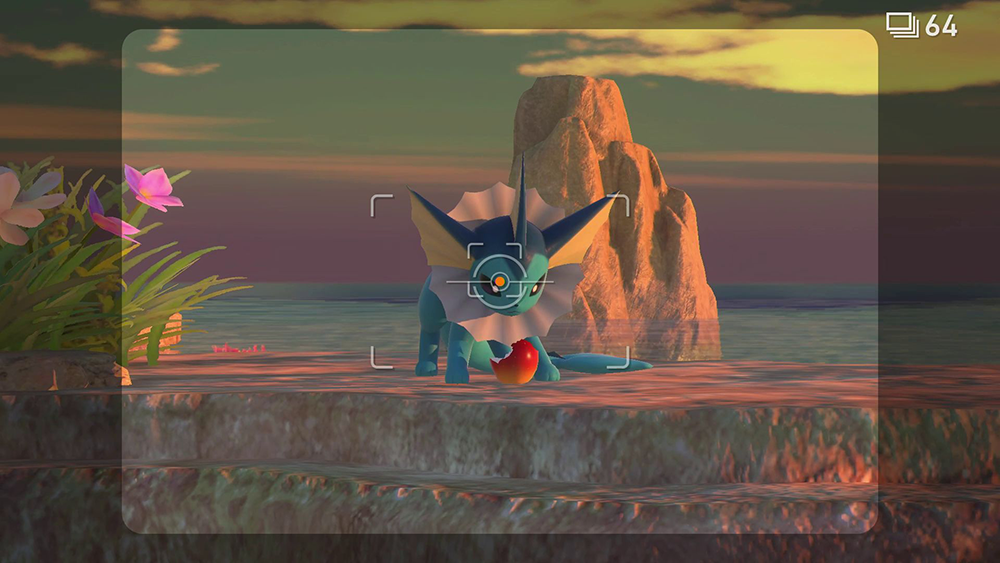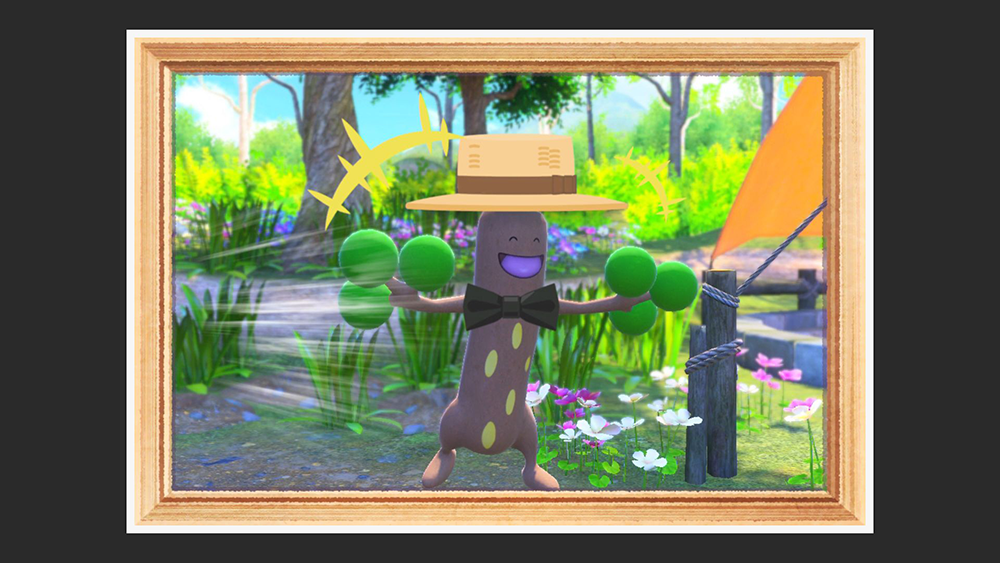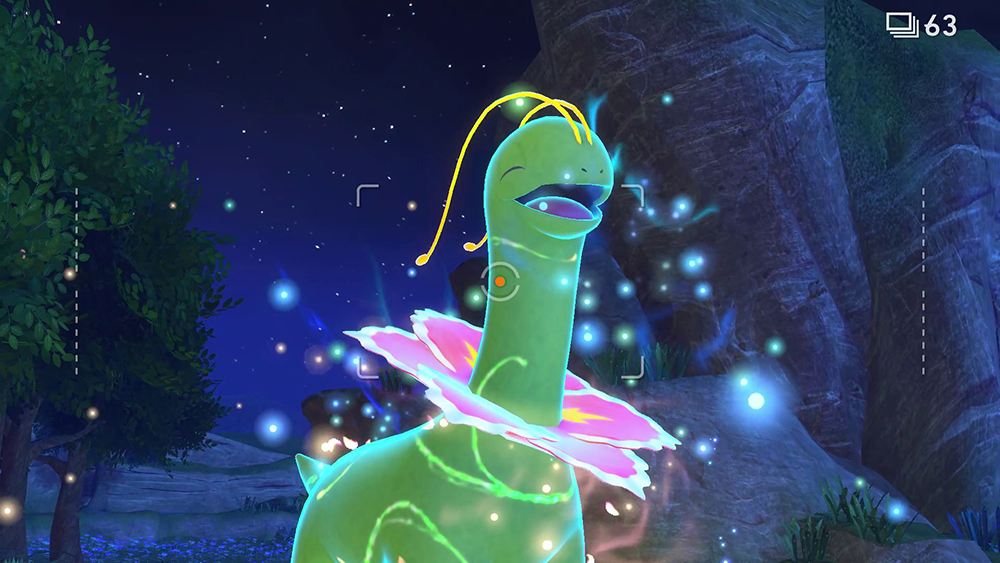Say cheese!
The original Pokemon Snap was released on Nintendo 64 in 1999. The beloved video game allowed players to take pictures of Pokemon that would be rated after completing a level.
Now more than 20 years later, New Pokemon Snap has been released on Nintendo Switch. We had the chance to check it out.
In New Pokemon Snap, players will travel to the Lental region of the Pokemon universe, where they’ll join Professor Mirror’s research team at the Laboratory of Ecology and Natural Sciences (L.E.N.S. for short). Players will need to help Professor Mirror investigate the Lental region’s mysterious “Illumina phenomenon” that causes Pokemon to glow. To do this, they’ll explore environments like forests, snowy mountains, and even the ocean floor, where they can take pictures of the region’s wild Pokemon. Along the way, players will fill in the pages of their Pokemon Photodex using the pictures they take.
New Pokemon Snap is an “on-rails” photography game, meaning the game will automatically take players through each environment as though they’re riding in a car that’s on a track, rather than allowing them to explore levels on their own.
During each level, the screen becomes the player’s camera, and a guide is placed in the center of the screen to help players line up their shots. Players can zoom in on Pokemon and other objects to see them more clearly and take better pictures. Plus, the camera will automatically identify and “lock on” to Pokemon as players aim their camera at them, which can further help them take the perfect picture (though, this particular feature isn’t perfect — more on that in a bit).
Each level features a different assortment of Pokemon to photograph, and these pocket monsters will automatically go about their lives as players move through the world. While it’s possible to take some lovely pictures as Pokemon live their lives without interruption, players can also use special tools to interact with Pokemon and the environment in an attempt to influence a Pokemon’s behavior.
For instance, they can play a song that may cause a sleeping Pokemon to wake up, or may inspire a Pokemon to dance. They can also toss Fluffruit at Pokemon to see if they’ll eat them (or react in a different way). Finally, as players learn about the Illumina phenomenon, they’ll unlock Illumina Orbs that they can toss at Pokemon to see if they’ll react.
Each Pokemon may react to tools differently. For instance, some may respond when hit with an Illumina Orb, while others will simply ignore it. Players will need to use trial and error to figure out which tools affect which Pokemon in order to take as many unique pictures as possible.

At the end of a level, players can choose one picture for each Pokemon species they photographed to be graded by Professor Mirror. The Professor will give each photo a score based on a number of factors, including the Pokemon’s size in the picture, whether or not other Pokemon can also be seen in the photo, and so on. Each photo will also receive a star rating from 1-4 stars, with higher star ratings being given to photos that feature more unique actions.
Even though players can only have one picture per Pokemon species graded after each level, they can save any of the photos they’ve taken to their in-game album for viewing or sharing later on.
Rather than only focusing on taking 4-star pictures, players will need to take pictures of all four star ratings to complete their Pokemon Photodex. That is, each page in the Pokemon Photodex can hold four different pictures of the same Pokemon species — one each at the 1-star, 2-star, 3-star, and 4-star ratings. As players take extra pictures for star ratings they’ve already completed, they’ll have the option to replace the current Photodex picture for that particular star rating with the one they just captured.
Once the player’s photos have been graded, the points they earned for their new photos will be added to their research score for the stage. Once they’ve earned enough points in a stage, its Research Level will increase, creating a new version of the level to play through. Each version of a level may feature different Pokemon to photograph, or it may have Pokemon in different areas or completing different actions.
As players progress through the game’s main research stages, they’ll have the opportunity to photograph special Illumina Pokemon in unique levels. Some of these levels contain a bit of puzzle solving, as players may need to use their tools (like Illumina Orbs and Fluffruit) to cause the Illumina Pokemon to appear so it can be photographed.
Finally, New Pokemon Snap allows players to edit their favorite photos with a variety of filters, frames, and stickers, and then share them with others online through the game’s version of Instagram. Players can give other players’ photos a “Sweet” rating if they like what they see. Unfortunately, players can only have six photos on their in-game profile at a single time. When they want to share an additional picture, they’ll need to delete a picture that’s currently on their profile to make room for the new image (the removed photos will still be available in the player’s album).

New Pokemon Snap features loads of adorable Pokemon and beautiful environments, and it’s fun to watch Pokemon interact with each other (or with you) as you move through their world. That being said, the gameplay is a bit lacking in variety, and you may need to play the same level multiple times to earn enough points to upgrade the stage to the next Research Level and advance the game’s story.
Similarly, if you decide to go for a complete Pokemon Photodex, you’ll need to prepare for a serious grind, as some 4-star photos take quick reflexes to set up and capture, and you may need to play each stage multiple times to take all of the photos you need (or use online guides that tell you what to do).
Finally, the game’s camera feels like it sometimes works against players. There are many times when two or more Pokemon will be very close together, and the camera may focus on (that is “lock on to”) a different pocket monster than you intended. You may have a split second to line up that perfect shot, but if the game decided you were trying to take a picture of Lapras, rather than Squirtle (as an example), you may have just wasted a few minutes and need to start the level over from the beginning before you can try to take the picture again.
While New Pokemon Snap is a family-friendly game, it contains a limited amount of voice acting, so players will need to know how to read to follow along with the game’s story.
In addition, players can type their own greeting that’s displayed on their in-game profile. It’s possible these greetings may contain inappropriate language. It may also be possible for players to use the game’s photo-editing tools to create inappropriate content. The game has a “Report” feature for these cases (for the record, we haven’t seen anything inappropriate in our time with the game).

Overall, we enjoyed our time with New Pokemon Snap, but when looking at the experience as a whole, the drive to complete the entire Pokemon Photodex turns the game into more work than play. That is, if you play through the storyline casually, doing only the minimum to move onto the next environment and push the story forward, the game is more fun, as you’re regularly introduced to new routes and Pokemon to photograph, and you’re less likely to feel “stuck” and “forced” to replay stages.
On the other hand, if you’re the type of player who typically goes for a complete Pokedex in Pokemon games, filling the entire Photodex will be a true test of your endurance, and you’ll need to decide whether the grind is really worth it.
New Pokemon Snap is now available on Switch for $59.99. The game is rated E for Everyone by the ESRB.
Disclosure: SuperParent received this game for coverage purposes.
Brandy Berthelson has been writing about video games and technology since 2006, with her work appearing on sites including AOL Games, Digital Spy, and Adweek. When she’s not gaming, Brandy enjoys crafting, baking, and traveling with her husband.